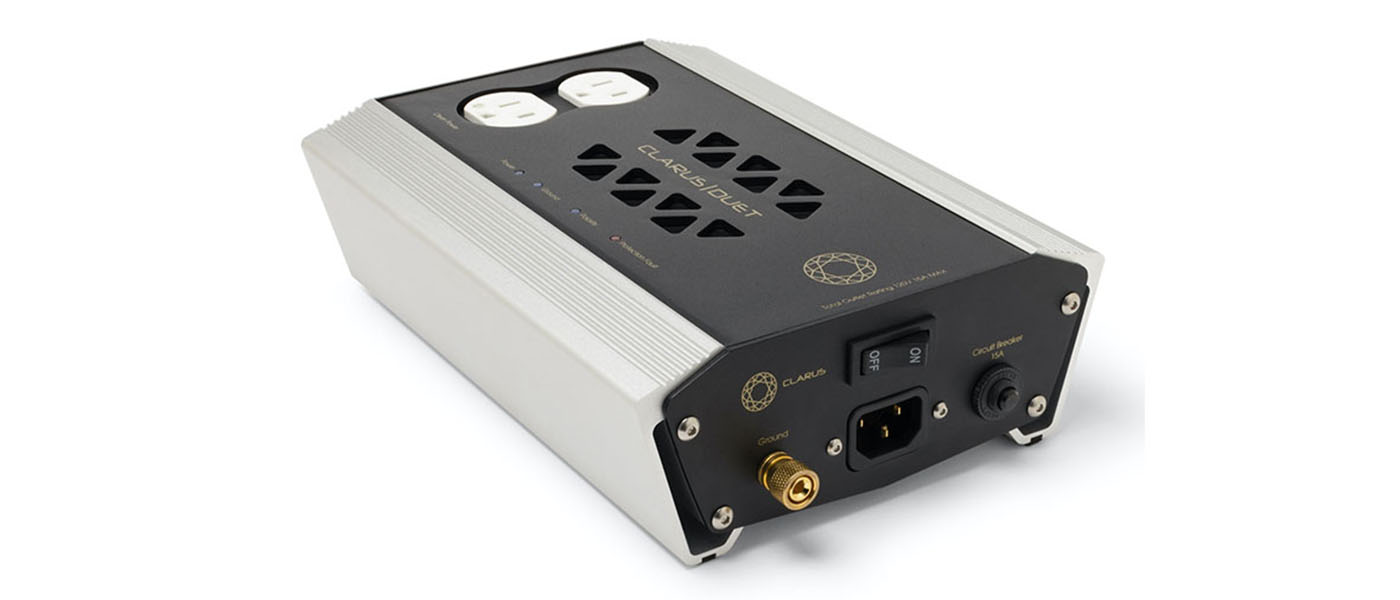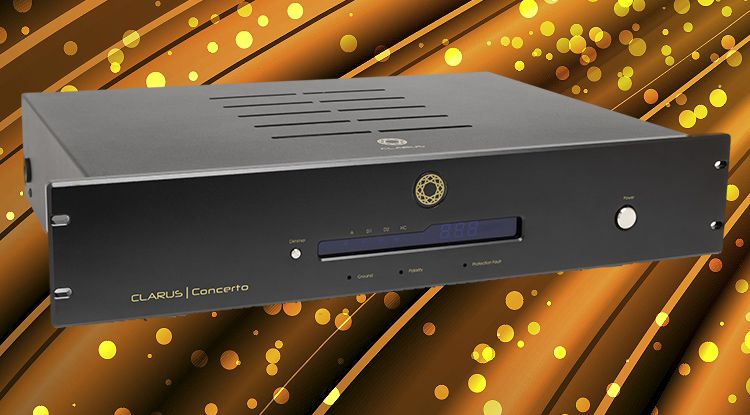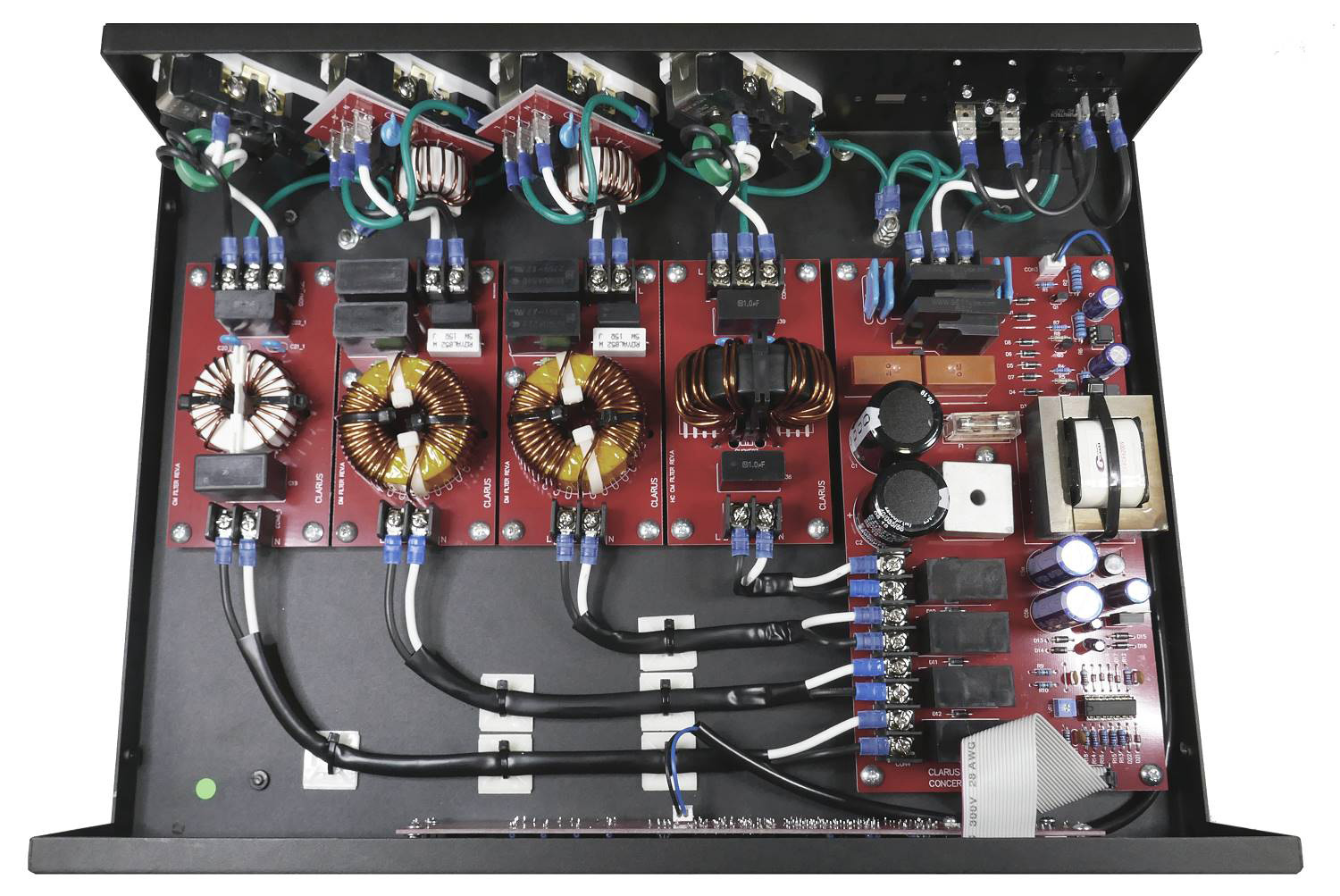However, there are many articles which suggest that they do, including some published here in Secrets.
The Clarus Concerto is a new addition to this category. It is very solid and has made use of past experiences with designing this type of product. (You can click on the following three photographs to see larger versions.)
Clarus Concerto Power Conditioner
- Excellent build quality.
- Four individual isolated dual socket 120 V outputs.
- It removes noise peaks even at –135 dBV.
Priced at $3,699, the Clarus Concerto is not an entry-level item, but these things are not easy to design or manufacture. They require heavy-duty circuitry because they need to handle 120 v AC, carrying high current. The filters have to be massive.
The Concerto makes use of the most modern technology available, including very high-quality inductors that are designed as low-pass filters which remove noise above 10 Hz.
The photo below shows the interior of the chassis. The round items are inductors. They consist of heavy-gauge copper wire coils that represent low-pass filters. These filters are designed to remove noise above certain frequencies. Inductors are included in speaker crossover networks. They are incorporated into the circuit that feeds the woofer, removing frequencies in the audio signal above a specific frequency, such as 60 Hz. In order for this specific frequency to be the low-pass, it has to have a certain number of windings (the number of times the copper wire is wound around the core). In the case of the Clarus Concerto, the coils have the number of windings to create a low-pass frequency of 10 Hz. That will remove the noise in frequencies above 10 Hz, including the AC noise of 60 Hz and its harmonics at 120 Hz, 180 Hz, 240 Hz, etc.
Secrets Sponsor
Each of the inductors has lengths of copper wire that were dipped into a trough of liquid polymer as they came out of the wire extruder. This results in a very thin dielectric (insulation). It is required because the dielectric affects the current flow.
The thickness of conductors affects the flow of specific frequencies, with more thickness (larger gauges) conducting low frequencies and reducing the flow of high frequencies. The gauge of the inductor wires in the Concerto are optimized for 60 Hz/120 VAC.
The Concerto sequentially powers-on each of the four pairs of AC outputs, which are High Current, Digital 1, Digital 2, and Analog. It also displays the output voltage.
You can see from the photo above that the digital outputs (the two sockets in the middle) have an additional inductor. These have the appropriate inductor windings to remove high-frequency noise in the digital range (16/44.1 has a frequency of 1.411 MHz and could be affected by radio-frequency noise from other sources in your home).
Number of output sockets:
EIGHT – TWO EACH FOR HIGH CURRENT, DIGITAL 1, DIGITAL 2, AND ANALOG
AC voltage readout panel:
Yes
Vibration Control:
reduces vibration in the inductors
Maximum Power Deliverable:
1,800 Watts, 120 VAC, 15 amperes
DIMENSIONS:
19” W x 3.5” H x 12.75” D
WEIGHT:
19 lbs (8.6 kg)
MSRP:
$3,699
Website:
Company:
SECRETS Tags:
Clarus, Concerto, Power Conditioners, Low-pass Filters, Noise Filters, Noise Filters Review 2020
Associated equipment included an OPPO BDP-105 Blu-ray Player, Bryston BDA-3.14 Streamer/DAC, Balanced Audio Technology VK-5i Pure Class A Triode (Tube) Stereo Preamplifier (Fully Balanced), Balanced Audio Technology VK-500 Solid State Stereo Power Amplifier (Fully Balanced) (250 Watts per Channel), and Magnepan 20.7 Planar Magnetic Full-Range Speakers. The cables were by Wireworld and Mogami.
I plugged the BDP-105 and BDA-3.14 into the Digital 1 socket on the Concerto, the VK-5i into the Analog socket, and the VK-500 into the High Current socket. For the bench tests, I plugged my computer and my Audio Precision spectrum analyzer into the Digital 1 socket.
I listened to music from a hard drive connected to the BDP-105 and to music streamed via Qobuz through the BDA-3.14 streamer/DAC. I used the Balanced XLR outputs from both of these sources.
I sensed that there was something different in the sound with the equipment connected to the Concerto, but I cannot define what that difference is.
There are a large number of articles about noise in audio systems, as well as video, and there is consensus, for the most part, that removing it is beneficial to the sound.
I performed a spectrum analysis on the noise floor and associated noise peaks using a computer with a sound card that is capable of achieving a -140 dBV floor.
Secrets Sponsor
The photo below shows the spectrum for a 1 kHz sine wave with the computer plugged into a 120 V AC wall socket (not plugged into the Clarus Concerto).
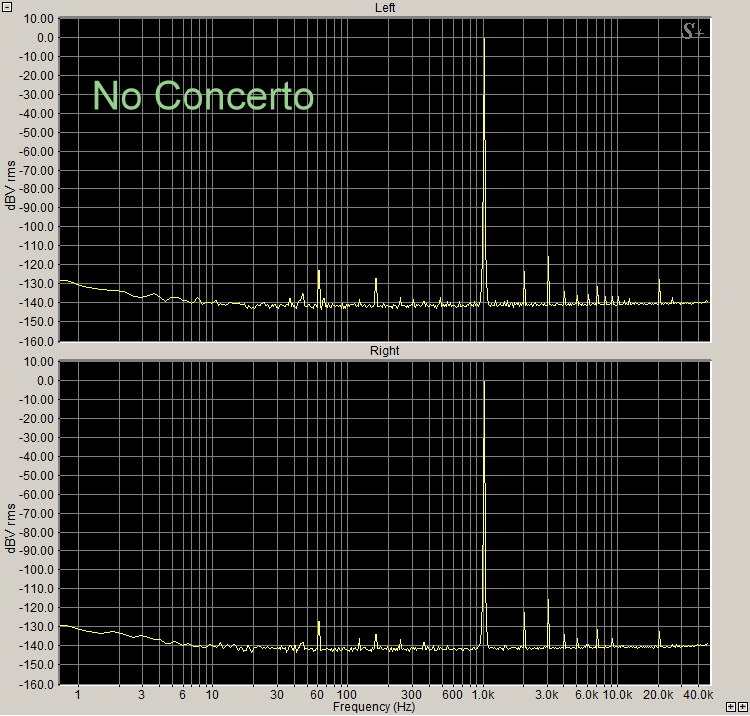
Here is the spectrum with the computer plugged into the Concerto. Notice that peaks present at 5 kHz, 6 kHz, 8 kHz, 10 kHz, and 20 kHz have been reduced.
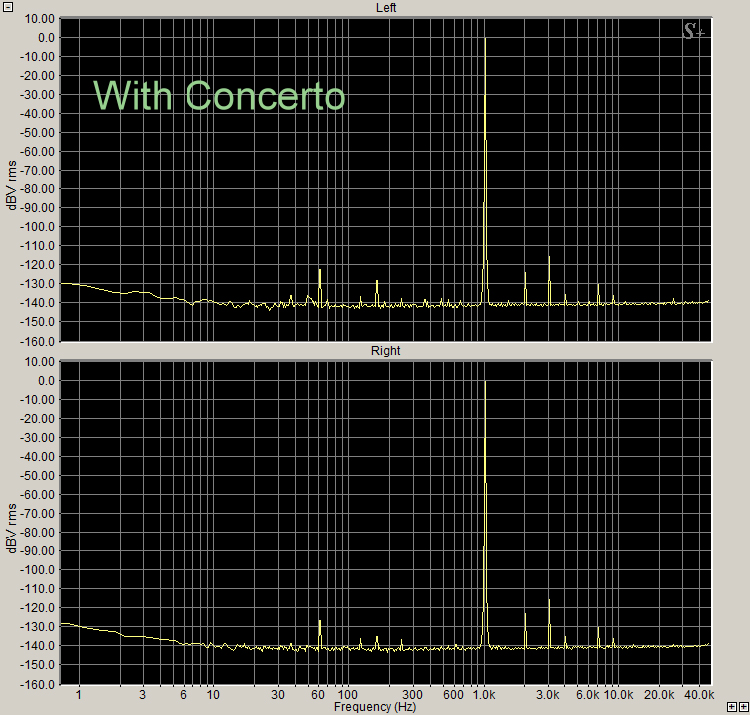
The AC peaks at 60 Hz and 180 Hz, which are AC peaks, have not been reduced. The peaks at 2 kHz, 3 kHz, 4 kHz, and 7 kHz also were not removed. Those peaks are produced within the sound card rather than in the AC power line.
I measured the noise floor on another product that I am reviewing, the Bryston BDA-3.14 Streamer/DAC. Here is a spectrum gathered when the Bryston was connected to the Concerto and was powered on, but with no test signal being generated.

Notice that there are a couple of AC peaks at -130 dBV or lower, and that is about all there is. The floor itself is mostly at -140 dBV. That is what I call a low noise floor!
The Clarus Concerto has C-Core technology which produces high permeability and low core-loss, and that results in very high efficiency, maximizing the removal of noise from the power lines. This C-Core technology is different than the C-Core technology in a power transformer.
- Excellent build quality.
- Isolated output sockets.
- It removes low-level high frequency noise.
- More output sockets for digital and analog circuits.
The point I want to make here is that high-end audio equipment will likely not have a lot of noise peaks because they already have noise-reducing circuitry. However, they may very well have some high-frequency noise that makes its way into the signal. The origin of this high-frequency noise is not known. It could be coming from anywhere in your home, including appliances, Wi-Fi router, etc. Everything these days seems to have Wi-Fi capability, so this noise can be in the megahertz range.
Removing high-frequency noise is a matter of your own priorities. If you want to maintain the purest signal possible, then adding a high-quality power conditioner is desirable. The Clarus Concerto is certainly of that category.
The benefits of a good power conditioner are well established because the science of noise filtration is highly developed, specifically using inductors to remove AC noise. However, removing noise peaks at extremely low levels is the domain of perfected power conditioners, which is what the Clarus Concerto is. When a power conditioner can remove noise peaks at – 135 dB, that is very impressive. This is really a good product. It’s well-built and effective for perfectionists who want only the music in their high-end gear. I am convinced that power conditioners are a necessary item, and our objective test results establish proof of performance for the Clarus Concerto.


